| Columns Retired Columns & Blogs |
Ensemble B-50 "Tiger" integrated amplifier Measurements
Sidebar 2: Measurements
I was listening to the LP of John Cale's and Lou Reed's tribute to Andy Warhol, Songs for Drella, in Guy's listening room. There was a palpability to the sound which, in all honesty, I had not experienced from Guy's Acoustats before.
"Okay, what's changed?" I asked, after Lou Reed's New York album had finished playing. I could see that Guy's customary Quicksilvers were not powered up, but there wasn't another pair of amplifiers at the speaker end of the room.
"I've connected up the Tiger."
"What Tiger?"
"Here." Guy pointed to a diminutive black box at the base of the Arcici Superstructure.
"You've got to review this."
And so he did. But not before dropping the little Tiger off at the Stereophile offices in order for me to give it a once-over with the Audio Precision System One and the rest of the magazine's test gear.
Before any measurements were done, the amp was preconditioned by driving both channels at one-third full power into 8 ohms for one hour. The heatsinks got quite warm during this period but not too hot to touch, suggesting that the inefficient horizontal layout of the heatsinks is not a problem. With the volume control full up, it took 68mV input at 1kHz to give 1W into 8 ohms, 508mV to clip the B-50 into 8 ohms, giving a maximum gain of 32dB, which is ample. The frequency response didn't vary with volume control position, but as can be seen from fig.1, features a somewhat restricted bandwidth, being 0.5dB down at 45Hz and 19kHz. The limited HF extension is also revealed by the waveform of a 10kHz squarewave (fig.2), which confirms the 7.5µs risetime quoted in the spec. While there was no difference in channel levels with the volume control full, with it set to 12 o'clock, as it was for the measurement shown in fig.1, there is a full 0.5dB of imbalance, which is quite poor volume-control tracking.
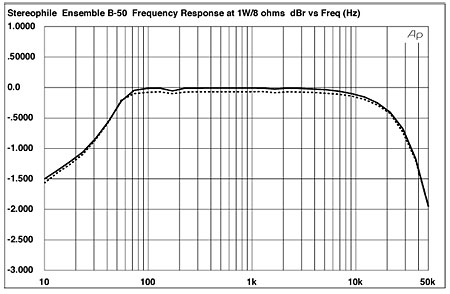
Fig.1 Ensemble B-50 Tiger, small-signal frequency response, volume control at 12:00 (right channel dashed, 0.5dB/vertical div.).
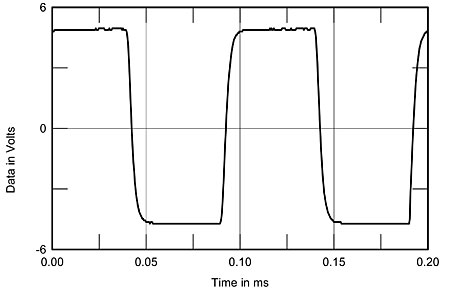
Fig.2 Ensemble B-50 Tiger, small-signal 10kHz squarewave into 8 ohms.
The input and output impedances were to specification, although the output impedance rose to 0.24 ohms at 20kHz, which is sufficiently low, in my opinion. Probing with an asymmetrical pulse revealed the Tiger to be polarity-correct, or non-inverting. DC offsets were negligible, while crosstalk was adequate at below 60dB below 8kHz. Above that frequency, capacitive coupling (probably across the volume control) resulted in a reduction in separation to 56dB at 20kHz; again, "good enough for jazz," as my musician friends were wont to say.
Measured distortion levels were higher than spec, as can be seen from fig.3, which plots THD+noise against frequency for 2.83V into three different loads—power equivalents of 1W into 8 ohms, 2W into 4 ohms, and 4W into 2 ohms. Midband distortion levels into the higher-impedance loads were reasonably low as well as being almost pure second harmonic, as implied by fig.4—which shows the shape of the distortion waveform at 1W into 8 ohms with the 1kHz fundamental notched out—and confirmed by fig.5, which shows the spectrum of the 1kHz waveform, with only the second, third, fourth, and sixth harmonics apparent above the measuring system's 12-bit noise floor. (The cursor shows the second harmonic to be highest in level, lying at –60.7dB referred to the fundamental level.) This kind of distortion is relatively benign subjectively, which may correlate with Guy's and my positive feelings about the Tiger's sound quality.
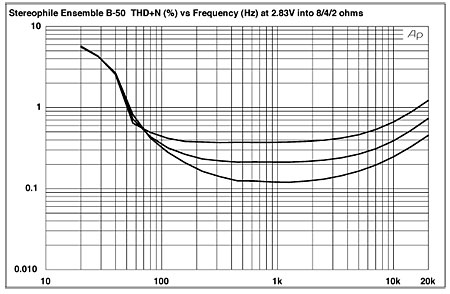
Fig.3 Ensemble B-50 Tiger, THD+noise (%) vs frequency at 2.83V into (from top to bottom): 2, 4, and 8 ohms.
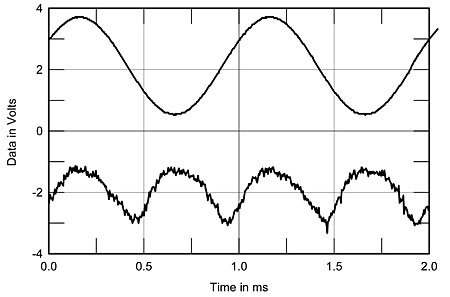
Fig.4 Ensemble B-50 Tiger, 1kHz waveform at 2.83V into 8 ohms (top), with noise and spuriae (bottom, not to scale).
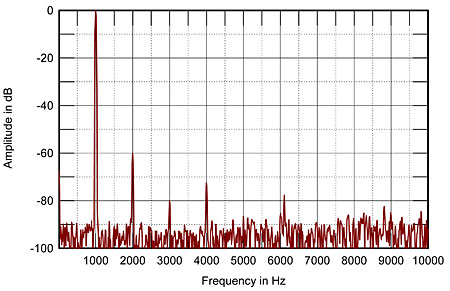
Fig.5 Ensemble B-50 Tiger, spectrum of 1kHz sinewave, DC–10kHz, at 1W into 8 ohms (linear frequency scale).
Nevertheless, fig.3 suggests that the amplifier is having to work very hard into low impedances—driving a 2 ohm load at around half power with a 1kHz squarewave caused the B-50's speaker-line fuse to pop after only 5s. The increase in distortion below 50Hz is presumably related to the B-50's relatively small power supply: fig.6 shows the distortion spectrum of a 50Hz tone with the amp driving a 4 ohm load at two-thirds full power. This is neither an amplifier to drive low-impedance speakers nor from which to demand wall-shattering levels of low bass; it is probably no coincidence that the speakers with which I have heard the Tiger sound sweet were either electrostatics or minimonitors, such as Ensemble's own Reference.
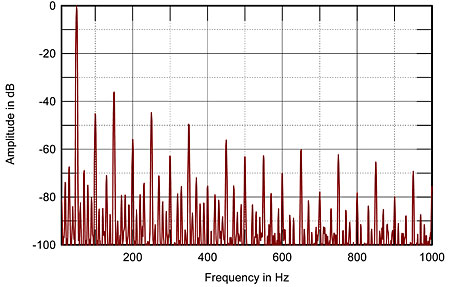
Fig.6 Ensemble B-50 Tiger, spectrum of 50Hz sinewave, DC–1kHz, at 50W into 4 ohms (linear frequency scale).
Finally, fig.7 shows the way the level of distortion and noise changes with output power into 8 and 4 ohms with just one channel driven. Below 5W into 8 ohms or 12 W into 4 ohms, the distortion drops with increasing power, suggesting that noise contributes to the measured figure (see also fig.4). Above those levels, the gradual rise in distortion—even above 1% it doesn't take off in the manner typical of a solid-state design—suggests somewhat of a "soft" nature to the amplifier's clipping behavior. Again, this is something that can make the audible effect of amplifier misbehavior subjectively benign. The way the distortion changes into a 2 ohm load is not shown, but THD started to rise much earlier than into 4 or 8 ohms, reaching 1% at a low level, just above 40W. This suggests that low-impedance loudspeakers must be avoided with the Tiger; in this respect, it's more of a tabby.
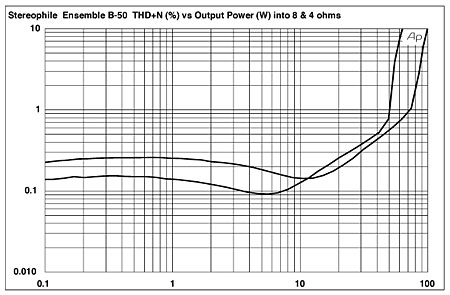
Fig.7 Ensemble B-50 Tiger, THD+noise (%) vs 1kHz continuous output power into 8 ohms (bottom trace below 10W) and 4 ohms (top curve below 10W).
Defining the clipping point as 1% THD gives maximum one-channel-driven output powers of 51.3W into 8 ohms (17.1dBW), 70.4W into 4 ohms (15.5dBW), and 40.2W into 2 ohms (10dBW). With both channels driven, the additional strain on the power supply results in a reduction in the maximum power delivery for the same 1% THD point: 44.1/44.4W (16.5dBW) into 8 ohms, and 57.2/64.9W (14.6/15.1dBW) into 4 ohms. (All these measurements were taken with the AC line voltage at 117V.) I have no idea why the left channel should reach 1% THD into 4 ohms some 0.5dBW before the right.
Taken in total, these measurements suggest that while the Tiger is definitely a small amplifier, when it does something wrong, it does so in a relatively graceful manner. While it would be foolhardy to offer this limited set of measurements as "explaining" the amplifier's musical sound, they do imply that under normal use and at sensible playback levels with appropriate speakers, subjectively it would hard to be offended by the sound—which is something at which traditional tube equipment has always excelled.—John Atkinson
- Log in or register to post comments




































